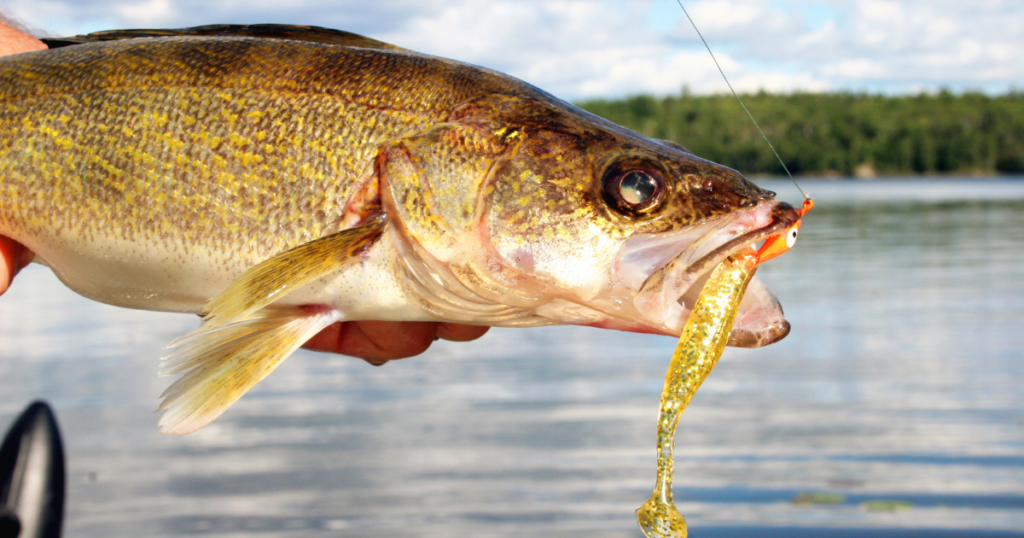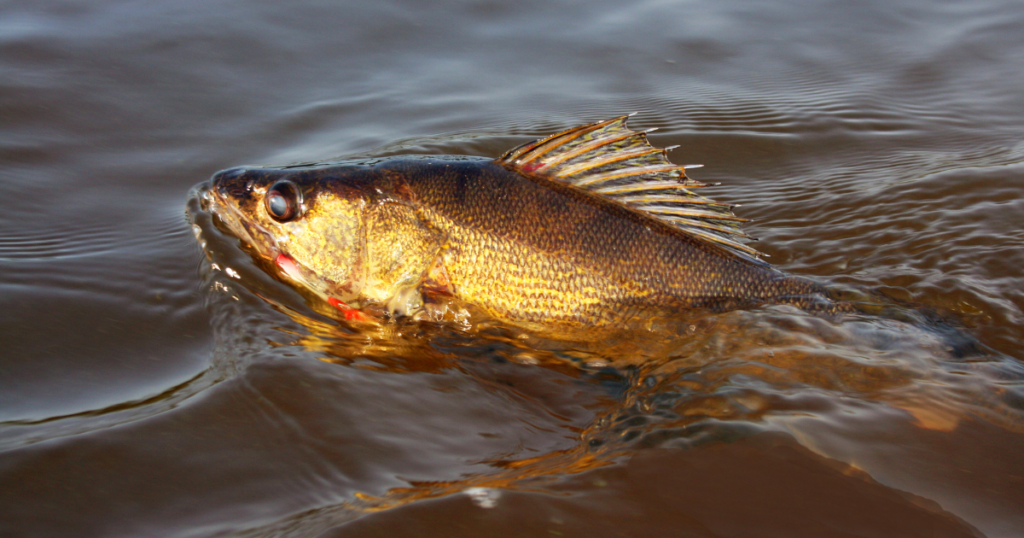Walleye lures such as crankbaits and soft plastics are a staple among the walleye elite. I recommend starting out with live bait, either jigging or rigging, to get your hands on some fish first.
If live bait is not readily available or you’re set on targeting trophies, then lures are the way to go. These are some of the most historically popular lures: Crankbait, Grubs, Paddle Tails, and Ring Worms. The best walleye lure of all time, grubs on a jig, are the most popular alternative to live bait.
If you want to fish fast and avoid keeping bait alive this is your primary option. I really like natural colors like black, white and brown. Tails tipped with chartreuse in these colors are effective in stained water. For beginners, I recommend a 3″ Grub. I really like 4″, but in the early stages you’re going to get a lot more action on a smaller profile that’s just long enough to ward off Panfish. Grubs in the 3-4″ range should be paired with 1/4 or 1/8 Oz. barbed jigs.
Grubs are great options off the dock or on the boat, and they let you cover more water than live bait as you’re able to cast and retrieve more frequently without jeopardizing the liveliness of your minnow. Jig, drag, or swim these along the bottom. Many of these techniques produce about a foot or so off the bottom.
Recommended Walleye Grub:
Catching Walleye On Crankbaits

Walleye crankbaits are predominantly known for their trolling applications, typically behind planer boards to spread multiple lures apart and to avoid the commotion generated from the boat and motor.
A deep diving crankbait that drives 10-13 Ft. down is required to reach typical walleye depths, a #8 in Firetiger is my favorite. These should be trolled along expansive Flats and Reefs during the summer months.
Trolling requires a boat and is somewhat advanced, but I recommend having a crankbait in your arsenal if you are a shoreline angler. These lures are great for searching out walleye, then alternating to a more targeted approach, like a slip bobber rig, once you can zone in. They will also catch a fair share of pike and bass which makes for exciting evenings on the water.
Click here to read more on slip bobbers.
Recommended Walleye Lures:
Walleye Fishing With Paddle Tails

I like to use paddle tails when I can locate schools of baitfish. Casting into a ball of bait with a tail thumping shad will work well, but I haven’t had much luck with them outside of deep summer and the fall. Mayfly hatch when baitfish are flourishing. In summer, if I can find a deep school of shad or cisco, I will thump a paddle tail along the bottom. During the Mayfly hatch when baitfish are near the surface I will swim the shad through the upper half of the water column. Beware, there will be a mixed bag of species in this approach. The general rule of thumb for paddle tail shads is to match-the-hatch so stick with natural colors like pearl, shad, smelt etc.
Recommended Walleye Lures:
How to Catch Walleye on Live Bait

Live bait is the key to bountiful walleye trips. Anyone who is just starting out should default to live bait as Walleye are generally more finicky and complicated to catch versus the typical freshwater fish. You want all the cards in your favor to start getting on fish. There is a time and place for crankbaits and soft plastics, albeit these are typically more advanced and are generally used to weed out the eater walleye and target trophies. Live bait is the best option when you’re first learning how to catch walleye.
Minnows
Minnows are the most popular bait option for walleye anglers, I have found consistent success with shiner and flathead minnows. When targeting bigger fish, shiners in the 4-6″ range are the mainstay, these will weed through some of the smaller fish and get you on 25″+ Walleye. If the bite is slow and I am marking fish, or if I am going for eater sized eyes I will use flathead minnows (2-3″).
Leeches & Worms
The second most popular option is leeches, typically in the large to jumbo sizes. These are a great option in walleye dominant bodies of water, however, in smaller bodies of water where perch, panfish and bass populations are robust, your leech will be the victim of theft. This can be true for nightcrawlers as well, however rigging them to worm harness spinners lengthens their profile which sorts through the pests. Minnows and leeches can be jigged, rigged, or floated on a slip bobber. Full nightcrawlers are typically saved for spinner rigs but can also be a great float option.
Recommended Live Bait For Walleye:
Walleye Jigs

Jigging is the most popular technique for targeting walleye, we will cover this tactic in more detail near the end. To jig you will need jig heads. For jigging live bait, it is critically important to use fireball style jigs. These are walleye specialized jig heads that have no lead barb on the base of the jig and the hook shank is short with a wide gap. This mold condenses the exposure of the jig + hook, giving your live bait a covert presentation.
You tip your jig by the lips of your minnow or the head of your leech so they can panic lively as you fish. However, bait rigged for jigging will not cover up the typical barbed-jig’s shank, so fireballs are the best option. I recommend 1/4 Oz. and 1/8 Oz. for most circumstances, you will rarely need anything larger and anything smaller is going to be ineffective in the typical walleye depth range of 15-30 Ft. Chartreuse is my go to color for live bait jigging, however I always have some glow colors as well for late evening and night bites.
Recommended Walleye Jigs:
Best Bait For Walleye In Summer
During the warm summer months, the best bait for catching walleye is a combination of live bait and artificial lures. In this season, walleyes are more active and tend to feed on a diverse range of prey.
Live bait, such as leeches, minnows, and nightcrawlers, are excellent choices because they closely resemble the natural diet of walleye, making them more enticing. Leeches, in particular, are quite effective due to their lively movements that attract the predator’s attention.
When it comes to artificial lures, deep-diving crankbaits and spinner rigs in natural or bright colors, such as silver, chartreuse, and orange, can be highly productive. These mimic the motion of baitfish and can be trolled or cast at various depths to cover a larger area, increasing the chances of attracting a hungry walleye. By experimenting with different live baits and lures, anglers can find the perfect combination to reel in the elusive walleye throughout the summer season.

For 25 years Green Bay Trophy Fishing has guided and provided helpful information to anglers in and around Door County. We are some of the most experienced fishing guides in Green Bay and pride ourselves on being experts on everything related to fishing in the area.
If you are interested in booking a walleye fishing charter, you can view our rates or contact us here.
